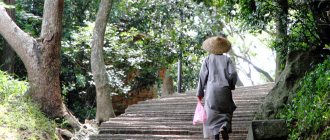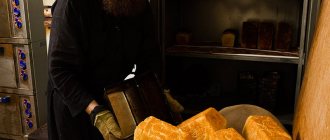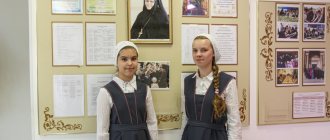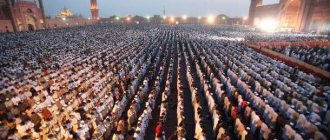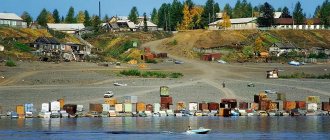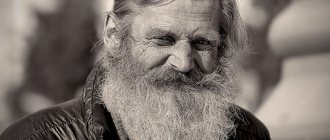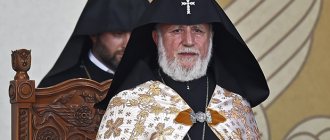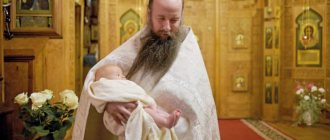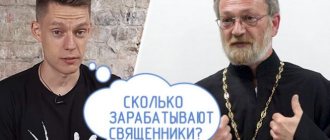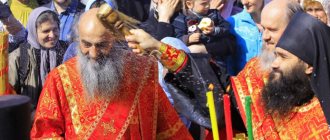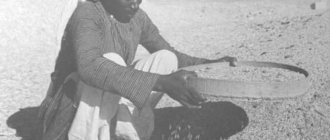We are fussing, spinning like a squirrel in a wheel, looking for... what? Did you notice? We are always missing something! We are always dissatisfied with something! We are always looking for the notorious meaning of life... But a real monk has already found it! The meaning of a monk’s life is in prayers for the whole world, for you, for me, for peace in the whole world. He is not looking for the meaning of life, because his life is already filled with meaning - to LOVE EVERYONE. Remember, “God is love!”
Monastic sketches
The monastery is where monks live in solitude, pray, work, serve God... In the Anthony-Dymsky monastery of the Tikhvin diocese, which stands on the shore of Lake Dymsky, 13 people strive.
They pray, work, return the monastery cathedral and other walls erected here to their original meaning... The line between work and prayer in the monastery is very conditional. The work of the monks, each in his own place separately, is replaced by joint prayer during the divine service. Individual work is accompanied by personal prayer. Prayer is the first duty of a monk, and work of obedience is the most important monastic virtue. Praise the name of the Lord, praise, servants of the Lord, who stand in the temple of the Lord, in the courtyards of the house of our God... While the kathismas are being read, Hierodeacon Alexander manages to knead the dough for the bread, which the next day for lunch will be on the tables in the monastery refectory, and return back to the temple, to the brethren.
“I have cleared the area from here to now,” Monk Alypiy, wiping drops of sweat from his wet forehead and adjusting his glasses on the bridge of his nose, points to a substantial section of the yard next to a tall woodpile. – I wanted to have time to make room for equipment: they will lay a sewer system here, they will even install it there, where there is nothing at all yet, but only planned...
Besides the monks, only three lay people pray at the all-night vigil. The Anthony-Dymsky Monastery has so far avoided the fate of some famous monasteries, where the world from which the monk is running comes for the monk, constantly reminding itself of itself with an endless line of not only pilgrims, but also tourists. “What else do we need? - the brethren ask a rhetorical question, nodding at the destroyed buildings around the Kazan Cathedral - the main monastery church. “We have everything for life!”
How long do Shaolin monks live?
Every person dreams of living a long, happy life to a ripe old age. But worldly problems, stress, poor nutrition, bad habits significantly reduce life expectancy. This does not apply in any way to men of monastic origin. Almost all of them live a long time, maintaining a sound mind, clear memory and the ability to lead an active life.
There is a completely reasonable explanation for this, which is contained in some internal rules of the monastery:
- daily cleaning of own cells with ventilation and humidification;
- complete absence of dust;
- a peaceful atmosphere in the home, the absence of unnecessary things;
- complete exclusion of scandals and stress;
- a favorable atmosphere in the home and in communication;
- modest, moderate diet, minimal consumption of steamed meat;
- complete absence of alcohol;
- loose clothing that does not impede movement;
- adherence to daily routine;
- daily breathing exercises;
- regular but moderate physical activity.
For lay people, such restrictions may seem quite strict. But the monks quickly become admirers of this way of life. However, they are not deprived of many of the benefits of civilization. There are televisions in the monastery, almost everyone has a mobile phone, many drive cars and study at universities. While outside the monastery, each of them strictly observes the lifestyle that he led previously. Maybe this is where the phenomenon of longevity lies.
Long road to the desert
– The Anthony-Dymsky Monastery is one of the best monasteries of the Russian Orthodox Church! I am telling you this not as a clergyman of a monastery courtyard, but as a person who is writing a dissertation on small monasteries of the Russian North - Priest Dimitry Ponomarev, a full-time priest of the Church of the Intercession of the Most Holy Theotokos on Borovaya in St. Petersburg, shares his views on modern Russian monasticism. – I have probably visited almost all the monasteries in the European part of Russia. And I can say with confidence: in fact, a more suitable place for a monk who wants to live a real spiritual life cannot be found.
It is not difficult to get to the Anthony-Dymsky Monastery from St. Petersburg by car. Father Dimitri and I loaded into an old minivan driven by the resident of the monastery, Monk Paisius, and set off. “235 kilometers, 3 hours 56 minutes on the road,” the Internet search engine calculated for me the time it would take to get to the village of Krasny Bronevik. This is the name of the locality in which the monastery is “registered”. “So,” I think, “we’ll be there by one o’clock in the afternoon.” In fact, all other things being equal, you can do it in three hours, or even two and a half. But not in our case. Firstly, a monk is driving, monks already live in eternity with their thoughts, and therefore they have a special relationship with time: for example, driving through Tikhvin, Father Paisiy gives us a short sightseeing tour of the city, which he, despite being a native of the Vologda region, knows how his five fingers - after all, before the Anthony-Dym monastery, he lived in the Tikhvin Mother of God Assumption Monastery. And secondly, on the way from the city to the monastery, Father Paisiy manages to fulfill several obediences assigned to him by the abbot of the monastery Adrian (Dementiev): stop at the hypermarket and buy seedlings for the monastery flowerbed, buy a fan, refuel the car - and this, of course, also takes time. <…>
The secret of the unique abilities of monks
The abilities of monks lie in vital energy and fortitude. Referred to as Qi energy. Correct use of this energy allows monks to achieve incredible heights in their art. Monks can control and subdue pain, and do exercises that are impossible for an ordinary person to repeat. Thanks to such skills, a special type of martial art, Shaolin Wushu, emerged. Training involves not only physical activity, but also psychological training.
Cognition and subjugation of Qi energy, the ability to influence and subjugate the physical forces of nature, the development of one’s own wisdom, the acquisition of superhuman abilities, this is only a small part of what partly explains the super abilities of monks. Every monk has foresight. It is impossible to take him by surprise; he will definitely feel the approach of danger.
The most cheerful worker
The Anthony-Dymsky Monastery is hidden from the busy highway on the shore of Lake Dymsky, among swamps and mixed forests. High humidity - and, as a result, the dominance of midges and mosquitoes...
“Yes, you have arrived at the most fertile time for bloodsuckers,” worker Dimitri comes out to meet us, smiling broadly, “now they have freedom.” But soon the dragonflies will come, and the mosquitoes will decrease: a dragonfly eats so many insects per day that their weight exceeds its own weight several times!
Demetrius is a distant relative of the Hieromartyr Hilarion (Troitsky)
“My great-grandfather, priest John of the Trinity, was the hieromartyr’s cousin. The priestly family of the Trinity was very large - they served in the Tula province and in the Yaroslavl province. And my great-grandfather, shortly before the revolution, was returning from an all-night vigil: it was dark, the lights were not on, he tripped on a cobblestone street, fell and broke his knee. The result is bone tuberculosis. My great-grandfather met the revolution already sick, in bed. My family is such an interesting one. Well, I...” Dimitri pauses for a short time and laughs, “and I smoke!”
Dimitri is probably the most cheerful person in the monastery. Looking at him, you wouldn’t think that he has a difficult life behind him...
How to live in the monasteries of Thailand
And now we will get acquainted with the life of monastic monasteries in Thailand. In Thai temples, the rise occurs early: around 4 a.m., and at about 5 a.m. the monks already go out to collect alms from lay residents.
This ceremony occurs daily and lay people believe that in this way they improve their karma and also receive blessings from the monks.
The monks go out barefoot and with special utensils to collect food. Residents must prepare fresh food specifically for alms, and most often this is hot food, rice with vegetables and fruits. When giving alms, worldly people must also take off their shoes. After gathering, the monks return to the monastery and begin their meal. Then it is time for meditation or study.
At 12 o'clock everyone breaks for lunch. In the temples of Thailand they eat twice a day and only vegetarian food. After noon, food is prohibited: you can only drink water, tea, milk or juice. After evening meditation, around 9 p.m., the monks go to bed.
Founder
Father Dimitri, candidate of theology, author of two monographs on the life of St. Anthony of Dymsky and the history of the monastery he created, shares his research discoveries:
– In the current church calendar, the date of death of Anthony of Dymsky is called 1224. Whereas in all the 35 copies of his Life known to us (both short and lengthy editions) it is indicated that he was born in 1206, founded the monastery in 1243, and died in 1273. The year 1224 appeared as an attempt to reconcile the dates of the life of St. Anthony with the dates of the life of his teacher Varlaam of Khutyn. The Lives say that the Monk Anthony was his peer. And when Anthony returns from his embassy to Byzantium, Varlaam Khutynsky, already on his deathbed, transfers the monastery to him as his peer. This word “peer” has misled many, because in the understanding of modern people, a peer is an equal in age. Archbishop Filaret (Gumilevsky) in 1860 in his book “The Lives of the Saints for January” writes in a footnote that Varlaam Khutynsky was born in 1156. Anthony Dymsky is his peer and, according to the Life, lived 67 years; add this to 1156 and get exactly 1224. But the Life also says that the grant of grant for the land around Lake Dymskoye (in order for a monastery to appear, you need land and a document for it) was given to the monk by the holy noble prince Alexander Nevsky. This is repeated by all lists of the Life of Anthony of Dymsky. Alexander Nevsky was born in 1222. And if Anthony Dymsky died in 1224, how could Alexander Nevsky give him a charter? The prince was then two years old. I propose to return to what was previously recorded in all handwritten copies of the Life of St. Anthony of Dymsky without exception - he was born in 1206 and died in 1273. But the problem is that in this case it will be necessary to revise the dates of the life of Varlaam Khutynsky, who, apparently, died not in 1193, but in 1243. By the way, church tradition says that he lived for 87 years, and the date of his death in 1243 looks more plausible.
The Legend of the Thirteen Warrior Monks
The first stories about amazing warrior monks appeared in the seventh century. In those days, the emperor was forced to turn to their help, since he lost his own throne. A detachment of 30 monks under the command of a martial arts instructor named Tanzong came to the defense.
A battle was fought, in which 13 monks from this detachment took part. The enemy was quickly defeated, and the throne was returned to the emperor. The monks fought on horseback, with only staves in their hands as weapons. In gratitude for his return, the emperor gave the monastery lands.
The space of the monastery
The main shrine of the monastery is the relics of St. Anthony of Dymsky, the founder of the monastery. They rest in the Kazan Church, the only functioning monastery church today. From the fraternal building (before the revolution it was a hotel for pilgrims) to the high bell tower of the temple, which managed to survive the era of oblivion, there are steps that have also been preserved from those ancient times. This staircase ran under the front monastery gates, built in the style of Alexander classicism. Here was the central entrance to the monastery, surrounded on all sides by a wall, topped with two-tiered towers at the four corners. Today there are no walls left - only a wooden fence follows their contour, no towers. The Kazan Cathedral also has not survived to this day intact: the dilapidated bell tower is, in fact, all that remains of the historical cathedral church. The monks of our time built a temple on it, on the bricks of which the names of hundreds and hundreds of donors, believers, who had the opportunity to make only this small contribution to the revival of the temple, can still be seen inscribed with a marker.
Daily routine in one of the Buddhist monasteries in Korea
Rising in the temple occurs very early, at 3-4 in the morning. One monk stands up first and begins to knock the bell. He walks throughout the monastery and reads sutras - such a ritual symbolizes awakening. The rest of the monks, hearing this sound, get up and begin preparing for the morning chanting ceremony.
After it, everyone goes about their business: some go to study, others go to cook. Breakfast starts at 6 am and usually consists of porridge and vegetables. After breakfast, everyone continues their activities: for example, most novices meditate at this time.
Then it's time for lunch. The traditional Buddhist lunch is rice and vegetables, because... Most monks do not eat meat or fish. The monks come with their own individual utensils and receive portions of food. There are no tables or chairs in the monastery, so during meals everyone sits as and where they want, for example, sitting on the steps.
There are chants before and after lunch. After the afternoon meal, everyone again continues their studies, classes and meditation. Novices are also required to work and help in the kitchen.
After 5 pm everyone gathers for evening chants before dinner, and after dinner it is time for evening meditation. In some temples, the monks do not have dinner, but only drink ginger tea.
When darkness falls everyone goes to bed. In general, monks live according to the rhythms of nature: they get up with the first rays of the sun and go to bed when it gets dark.
Monk with a telling surname
At the beginning of the 21st century, the central entrance to the monastery is located completely different from where it was located before the revolution. The first building that a person enters sees is the gatekeeper's house. It was made by the monastery carpenter, Monk Pavel. Pavel’s father’s surname is telling – Plotnikov.
– When I entered the monastery seven years ago, the then abbot, abbot Ignatius (Buzin) (now the Bishop of Armavir and Labinsk - Ed.) asked what my name was. “Oh, Plotnikov,” he rejoiced, “well, you’ll be our carpenter.” But in my family, indeed, there are quite a few master carpenters.
Much in the monastery is the work of Father Paul: from icon cases in the monastery cells to the lectern and iconostasis in the church. And only in the master’s cell there is not a single piece of furniture that he made himself.
“The shoemaker is always without boots,” the monk laughs, showing me his humble abode.
Bed, table, bedside table, a couple of stools. There is an ironing board against the wall. The bed is enclosed by a small screen, and this makes the door look like a hallway. On the nightstand is a photograph of a smiling woman with children. It turned out that these were the daughter and grandchildren of Father Pavel.
- They are great! - He says lovingly looking at the photo. – My daughter knows several languages, my granddaughter draws. They visit me sometimes.
Shaolin reforms
At the turn of the 10th and 11th centuries, a special detachment was created in the monastery, which included warrior monks. They were ready at any moment to resist any enemy, to protect their own monastery and their emperor. It is impossible to enter into battle without special skills. This way you can be defeated and betray your own country.
In the 13th century, a new abbot named Fuyu began training warriors. He was outraged by the fact that most of the monks began to leave the walls of the monastery and return to worldly pleasures. Such traitors boasted of their skills among the Merians and tried to present themselves as some kind of superheroes, praising their past exploits. This was contrary to the philosophy and commandments of the monk. After several similar cases, the abbot gathered the monks and proposed introducing special exams or tests for each applicant. This trend continues to this day.
Border inside and outside
There are 13 people in the monastery: an abbot, one hieromonk, two hierodeacons, five monks, a monk and three novices. This is a lot by today's standards, especially for small monasteries such as Antoniyevo-Dymsky. The “secret of success” lies in the fact that they are trying to build a proper monastic community, putting the spiritual life of the brethren in first place.
– Are you familiar with stories about how a once quiet, secluded monastery turned into a tourist center with the arrival of major sponsors? – asks the abbot of the monastery Adrian (Dementyev). - We are afraid of this. Don’t think that I don’t want to restore the monastery from ruins, we are doing this to the best of our ability and capabilities, but first we need to create all the conditions for the brethren so that they can lead a solitary life, separated from the outside world, learn and love it by the time, when the monastery complex is restored and there will be many more pilgrims. Otherwise, what is the point of being a monk? It will turn out to be the same layman, only in different clothes.
It is very important to be able to draw the boundary between the monks and the world not only along the territory of the monastery - for example, completely limiting the access of pilgrims to the fraternal corps and the internal life of the monastery, leaving the temple with shrines accessible to them - but also in the soul of the monks themselves, which is much more difficult. Partly from these considerations, the Anthony-Dymsky Monastery developed its own internal charter - an experience unique to our days.
“We took as a basis the Charter of the Trinity-Sergius Lavra and the “Regulations on monasteries and monastics” adopted by the Russian Orthodox Church at the end of 2021,” says Abbot Adrian. – We have written down many points that are not taken into account in the “Regulations” (because this is a general document drawn up for all monasteries in Russia), and which are not in the Lavra Charter, adopted back in 1959, but are in the life of the Dymskaya Monastery. Let me give you an example. Today, almost everyone has a mobile phone in their pocket – and there is the Internet, instant messengers. It turns out that the person went to a monastery, but in fact he is always in touch with the world. And we have stated in our charter, which orients a person towards monastic life, that staying in a monastery does not imply the use of the Internet and mobile communications. This may be permitted, for example, for students in theological schools or for some other need, but with the blessing of the abbot, and will be organized, for example, in the library of the monastery. However, I am not a supporter of coercive measures: the monk himself must come to the point of stopping using the telephone and computer. This choice is voluntary, but also necessary: a monk will not break with the world if the world is “in his pocket.” A monk should reduce his time of communication with the world, and increase his time with God. Let every newcomer to us become familiar with the Charter, and if he is ready to live by such rules, welcome.
Philosophy of the Shaolin Monastery
It is based on the teachings of Damo, which celebrate courage and valor. Before the advent of Bodhidharma's teachings, fighting skills were used to destroy and plunder. Only after the appearance of Damo, martial art began to be seen as one of the types of spiritual development, self-defense, protection of the weaker.
A monk, who is also a Shaolin warrior, is obliged to:
- defend yourself, but do not kill the enemy;
- use only for good the skills and knowledge acquired in anatomy and medicine (it is enough to influence the point to knock out the enemy).
The inhabitants of the monastery and Shaolin itself were often subject to invasions. Only in this case could the monk kill the uninvited guest. Therefore, robbers often avoided Shaolin for fear of being destroyed without the use of weapons. History knows of cases where bandits were more afraid of monks than armed soldiers. This is explained by the fact that one day one monk was able to resist a detachment of armed soldiers, after which he remained alive.
But combat ability has never been the basis of philosophy. More attention is paid to spiritual development and observance of certain commandments:
- the monk never attacks first;
- a monk cannot fight another monk;
- Shaolin are not warriors;
- all knowledge and skills are used only for self-defense.
To confirm this, there is a full-length monument to the monk in front of the main entrance. The inscription on it says that the monks came in peace, do not wish harm to anyone, but are able to protect themselves.
Meet the Economy
Hierodeacon Nikon (Kozhevnikov) is the most severe monk in appearance. And this is correct, because a housekeeper in a monastery is the same as an executive director in an enterprise; the direct management of the entire material life of the monastery is concentrated in his hands. He is the abbot's assistant in the economic activities of the monastery. You have to control everything - from the process of collecting firewood to laying the water supply. And Father Nikon is the one who is usually the first to talk with a person who wants to work in a monastery, to become a novice.
“The idea of monastic life is formed from books, pictures or films,” says Father Nikon. – In fact, it is much heavier than these pastoral descriptions. We must immediately warn you about this: if you run to us from problems, then you will not succeed in the monastery. It’s better not to even try - otherwise it will be worse. And who will be to blame? Lord?! Because the old unresolved problems will definitely find you here, and it will be even worse than in the world. We had to send some of the monks back home - people couldn’t cope and provoked conflicts with the brethren. A monastery is an ark of salvation, a small community, so it also happens that some disagreements cannot be avoided. Need a lot of patience!
History of Shaolin
The history goes back many centuries. During this time, the Shaolin Temple was shrouded in endless legends and myths. The temple was founded by a monk from India, Bhadra, back in 495. The founder decided to locate it on Mount Sunshan. This place was not chosen by chance, as it was considered holy. Taoist saints, who were considered immortal, as well as hermits settled here. At the time of its inception, the monastery looked quite modest. It was just a few wooden houses. But the founder, who later became the first abbot, wanted to see Shaolin as something special, exceptional. He decided to create a kind of Buddhist pearl in China.
To realize his plans, the founder carefully approached not only the choice of location and the structure of buildings. It was equally important to find and train the first monks. The Shaolin Monastery developed rapidly. In the first years, it numbered several dozen novices, the number of which was constantly increasing. These were people from among the hermits, and after a few years Shaolin already numbered several hundred people. The main principle of the inhabitants of the monastery is the insight of Buddha. These are classes that included various meditations, regular wushu classes, and active physical exercises. Residents of the monastery must constantly improve the territory and its buildings.
Special attention was paid in the Shaolin monastery to the techniques of quanshi (fist fighting), the martial art of wujiaotou, which involves the use of edged weapons. Moreover, all types of weapons available in the monastery were invented by the monks.
The founder of the Buddhist temple did not always find a common language among the inhabitants of the monastery. He decided to retire to a cave, where he meditated for 9 years, depriving himself of sleep. But one day he couldn’t stand it and fell asleep. His anger at himself upon awakening was brutal. He tore out and threw away his eyelashes. According to legend, now amazing tea grows in this place, which they drink during their meditations.
Father Anthony
In the Anthony-Dymsky Monastery there are two priests - abbot of the monastery Adrian (Dementyev) and hieromonk Anthony (Brovarenko) - the treasurer.
Father Anthony is completely devoid of panache and is surprisingly simple and direct in his communication. However, this can be said about most of the local inhabitants, but Father Anthony stands out even against their background. His main obedience is working on the monastery farm. He spends most of his life in the company of cows, chickens and geese, leaving the barn only to go to church for worship, to his cell to sleep, and to the refectory for lunch and dinner. However, the latter is not always true: it happens that Father Anthony has lunch right there, at his workplace. Sometimes he even sleeps here - in a small fenced-off closet with a refrigerator, a table and an old sideboard, in which a wide variety of veterinary drugs are stored behind glass.
The monastic path of Father Anthony began with the Holy Trinity Sergius Primorsky Hermitage in Strelna (St. Petersburg). The current Bishop of Armavir and Labinsk, and then Hieromonk Ignatius (Buzin), served there as dean. Together with him and another monk, Father Anthony traveled from the Sergius Hermitage, first to the courtyard of the Konevsky Monastery in Priozersk, where he was tonsured into the mantle, and then to the Tikhvin Dormition Monastery, to which the Antoniyevo-Dymsky monastery was then assigned as a monastery.
“When the Dymsky Monastery became independent, Father Ignatius was appointed abbot,” he says. – Before this, the skete was run by Hieromonk Nikita; by the way, he later left the world, married, with children. It happens in monastic life, so why hide it? My opinion is that most of the defrocked people simply took monastic vows too early; they should have been novices longer and had more time to think.
By the way, Father Anthony’s cows are amazingly clean and washed; I have never seen such well-groomed cows on any farm.
- Well, why do they have to be dirty? - the monk is surprised. - We love them.
Shaolin Monastery
The active development of tourism and great interest in Buddhism have turned the temple into a place of tourist pilgrimage. Each Shaolin monk is unique and arouses genuine interest. The Chinese government, assessing this situation, decided to contribute considerable funds to the development of the Shaolin Temple. Interest in martial arts forced the country's leadership to build several sports schools close to the temple, where modern monks teach the art of combat.
Modern Shaolins adhere to certain principles in life. They have no right to violate them. This:
- Clean your home daily using the triple principle (walls, floor, clothes);
- constantly strengthen your body and spirit by performing certain exercises;
- I improve martial art not for my own protection, but to improve health and improve blood circulation;
- treat your mentor with respect in your daily interactions with him;
- do not neglect communication with the laity, be courteous with your brothers;
- never stoop to a showdown;
- eating meat and wine is a grave sin;
- sodomy, women lead to the wrath of heaven, all monks must exclude this;
- do not teach combat techniques to lay people who have no desire to learn it;
- Eliminate the spirit of competition from your life, observe the rules of decency.
These are the main, but not all, commandments that every Chinese Shaolin monk adheres to. This lifestyle, daily cleaning and exercise, has a beneficial effect on the health of each inhabitant of the monastery and, probably, partly explains the reason for their longevity.
“My husband and I have long dreamed of visiting this unique place and exploring it from the inside. I was amazed by the incredible purity of the air. And the monks’ cells are fresh and cozy. My idea of the monks' dwellings was still different. Kind, hospitable hosts put us up in a comfortable hotel and treated us to vegetarian dishes. Quite tasty. We learned that the food is prepared by ordinary lay people. Combat skill in general is worth talking about separately. And needless to say, it’s a must see! Everyone should visit here at least once.” Anna. Ekaterinburg.
Two different ways
The Anthony-Dymsky Monastery has the following tradition: every day at lunch, Abbot Adrian personally pours soup into plates for the brethren. This is one of the forms of the abbot’s service to the inhabitants - following Christ’s commandment. Let the greatest of you be your servant (Matthew 23:11).
– As an outside observer, I notice one big difference in the structure of life of this monastery from many other monasteries. This is simplicity in relationships, says the priest of the monastery in St. Petersburg, Priest Dimitry Ponomarev, “in no case is it familiarity, but simplicity, cordiality. I will even say that the Dymsky monk is immediately visible: everything is very natural.
Each of the monks has their own story of coming to the monastery. Abbot Adrian, for example, says that his path to monasticism was quite smooth and calm. Coming from a simple working-class family, he attended a regular high school and played guitar in a music group. Then he began to read the Gospel at the dawn of the revival of the Church in the early 1990s, and then he began to go to church - the first revelation about the existence of other meanings was a visit with a school friend to the Alexander Nevsky Lavra, where the friend venerated the icon, which greatly surprised the future abbot. While still at school, Father Adrian began attending divine services, entered the Institute of Theology and Philosophy, from where he was drafted into the army, because the institute did not give a deferment. After the army, he worked as an apartment decorator. In 1998, Abbot Lukian (Kutsenko), now Archbishop of Blagoveshchensk and Tyndinsky, invited him to work for two months at the monastery of St. Alexander of Svirsky... Two months turned into twenty years.
Hieromonk Anthony, on the contrary, says that in his youth he lived a life as far removed from faith as possible. Some of his friends from that time are no longer alive - they died from drugs. He is an electrical engineer by training, or, as he jokes, “an engineer minus an electrician.” He was baptized in 1994 “for safety reasons”: so that “no misfortune would happen.” And only a year after this event I decided to read the Bible - you need to know what is written there.
“I didn’t understand what was written, but something was deposited in the subconscious. And only then I heard radio “Radonezh” from a friend and decided to read something about Orthodoxy.
At first, Pavel (the name of Father Anthony in the world) wanted to buy “The Ladder” in the church shop, but it was not there, and he purchased “Margaret the Spiritual.”
“That’s when I realized: monasticism is mine.”
Monastery of John the Baptist, UK
A disciple of the great elder Reverend Silouan of Athos, Father Sophrony (Sakharov) (1896 - 1993), by the will of fate, ended up in England, where he settled in a quiet place with his disciples. Little by little the monastery has grown, but it is still not large, but it is important because hesychast spiritual texts and works have taken root in Great Britain. By the way, Prince Charles respects hesychasm very much and regularly lives on Mount Athos in the Vatopedi monastery.
There is a funny story about the founding of the monastery. Upon arrival, the local pastor, Fr. Sophronia was very interested in what was happening there, who were they, these Orthodox Christians? And he asked his bishop: “What is this - a sect? Do they even believe in the Holy Trinity?” And the bishop said: “Don't worry. They are orthodox. They are the ones who invented it." (They are Orthodox, they created the doctrine about it).
Sergei Khoruzhy: “The process that began from below in Russian monasticism, as well as outside Russia through the activities of St. Paisiy Velichkovsky (1722-1794) and his students gradually grew into the Russian hesychast revival of the 19th-20th centuries. Its main milestones are the creation and dissemination of the Russian “Philokalia” (a fundamental set of hesychast texts, which was revised and supplemented more than once and became the basic guide for organizing Orthodox consciousness and life); the creation of influential centers of hesychasm (Optina Pustyn, Valaam, Sarov, etc.); the feat of the teachers of Russian hesychasm - St. Tikhon of Zadonsk, Seraphim of Sarov, Ignatius Brianchaninov, Theophan the Recluse, in our century - St. Silouan of Athos and his student Abbot Sophrony (Sakharov); the formation of new forms of hesychasm - pilgrimage and, in particular, eldership. New forms showed that a special feature of Russian hesychasm is the widespread development of the tendency outlined by Palamas towards the establishment of hesychasm as a universal, general anthropological strategy: in contrast to the ancient institution of elders - mentors of monks, in the Russian eldership, as well as in the “Monastery in the World” movement, coming from the Slavophiles and developed in our century, including during the Bolshevik persecutions, hesychasm is coming out into the world.”
From sports to monks
And the dean of the Antoniyevo-Dymsky monastery, hierodeacon [1] Alexander (Semak), realized that monasticism was his thing when he came, with the blessing of Archpriest Nikolai Belyaev, from the Ioannovsky stauropegic monastery on Karpovka to work in Antoniyevo-Dymsky.
Father Alexander is probably the most modest resident of the monastery. He describes the story of his life in general phrases, as if he does not want memories of the past to intrude into his current monastic life. He was born in Voronezh, studied in Moscow, and then went in for sports professionally. One day, friends asked him to become godfather to their child - and so, once in the temple, the future monk wanted to return under its arches again.
– The most important thing in monastic life is, indeed, patience. What is needed here is not a cartload, but a whole convoy. But even more important is the desire to serve God and grow spiritually. Without this, even patience will not help,” says Father Alexander.
Father Alexander is also the monastery cook. Every day, whether alone or with helpers, he manages to feed his brethren their fill and tasty food. Not an easy task. He copes with it perfectly well. And the lightly salted monastery cucumbers that are always on the table are absolutely incomparable. And he also bakes prosphora and bread.
“So my story is the simplest,” this wonderful monk modestly sums up the story, not really wanting to publicly replicate the details of his life.
So we won’t do this.
Names of Shaolin monks
They are given at the time of tonsure. This is usually done by the trimmer. Names are made up of several syllables. You can look at this as an example:
- Shi or Sha is the surname of all Buddhists;
- the second syllable in the name is the surname of the dynasty;
- the third syllable is the proper name that the monk receives at the time of tonsure.
It is rare, but it happens that new monks want to preserve the name they bore in the world. No one will resist this. But the vow at the time of tonsure cannot be avoided. The monk renounces worldly desires. It's like being reborn. From now on, the birthday is considered not the day that was listed in the passport, but the day of tonsure. This is the day of his angel and all the monks congratulate him on this day.
The first temple of Anthony of Dymsky
Hegumen Adrian tells what restoration work he would like to carry out first:
– First of all, we need to complete the cathedral church. Services are currently only taking place in the lower Kazan Church. When we complete all the work on the second floor, the upper temple will become Kazan, and the lower one will become the temple of St. Anthony of Dymsky.
By the way, in Russia there is not yet a single temple in honor of this saint. In order for the abbot's idea to come true, it is necessary to master a huge scope of work - for example, move the temple shop to another place in order to make a staircase to the upper temple in its place, but first build five domes, repair the bell tower and roof. This has already begun.
Cloth
The clothing of the monks also arouses keen interest among the public. A cassock is a long robe that reaches to the heels. It has narrow sleeves and the collar is buttoned tightly. The cassock is an undergarment. If worn by a monk, the item should be black. Cassocks of other colors (gray, brown, white, dark blue) can only be afforded by family clergy. Traditionally, they are made from wool, cloth, satin, and linen.
Of course, the clothing of monks is not only a cassock. The outer garment of a person who has dedicated himself to God is called a cassock. Traditionally, it has long and wide sleeves. Black cassocks are most widespread, but you can also find white, cream, gray, and brown versions.
Not former, but current
And yet, a monastery is, first of all, not walls, or even a temple, but people who give meaning to such buildings. What were these walls without monks just recently? A school for tractor drivers, a psychiatric hospital, a warehouse, a sanatorium. And the word “monastery” could only be used in relation to this place by adding “former” to it. Now they pray within these walls again. Here again is a monastery. Hegumen Adrian, Fathers Anthony, Nikon and Alexander, the rest of the monks, monks and novices - these are the people who return the walls to their original meaning, transferring the monastery from the “former” category to the “current” category.
[1] Shortly after the first publication of the article, on September 9, 2021, His Eminence Mstislav, Bishop of Tikhvin and Lodeynopol, ordained Hierodeacon Alexander (Semak), a resident of the Anthony-Dymsky Monastery, as a hieromonk. – Note. editors of the website "Monastery Bulletin".
Evgeniy Perevalov
Photo: Stanislav Marchenko. Photos from the monastery website are also published
Published with abbreviations
Autonomous Monastic State of the Holy Mountain, Greece
Joseph the Hesychast, Silouan of Athos, Paisius the Holy Mountain, other prayer books and their living followers have revived the spiritual path of hesychasm in monastic life on the Holy Mountain since the 20th century, or, rather, given it a new impetus. Now in different secluded places of Athos there are several hesychastiria - desert cells, where hesychast monks live, respectively. Athos is an international center of hesychasm; moreover, for example, Bulgarian hesychast monks traditionally live on Athos, and not in Bulgarian monasteries.
Photo
September 28, 2021 Source: Living Water. St. Petersburg Church Bulletin
Orthodox monasteries in Russia
The number of monasteries began to grow sharply after the adoption of church reform by Tsar Alexei Mikhailovich and Patriarch Nikon. Part of the clergy did not accept it, and opponents of the new rules were persecuted by the authorities and the church. As a result, in order to avoid punishment, they went into the deep forests and founded monasteries, settling away from cities and villages.
Chelyabinsk region, Old Believer monastery
The Old Believers called any building where believers lived a monastery. These were huts, similar to hunting lodges, and large settlements with permanent buildings.
They differed from ordinary secular villages in their isolation and running their own household. In remote places, cells and temples located at a great distance from each other were connected to each other by camouflaged underground passages. In case of danger, the monks disappeared, moving to their brothers.
Women's Orthodox hermitages
Women were allowed into the monastery only as part of a religious procession on holidays. Among the Christian believers there were enough willing to devote themselves to the service of the Lord.
Seraphim-Znamensky Skete
In the south of the Moscow region, in Domodedovo, there is a convent. It is famous in the world for the fact that in it anyone can meet true Faith, receive Hope and know Love. Its inhabitants went through difficult times, but everything is behind them, the nuns’ lives are getting better.
Pokrovsky Skete
In a deep forest near St. Petersburg there is a beautiful temple. It houses sisters who combine serving God with helping people suffering from drug addiction.
